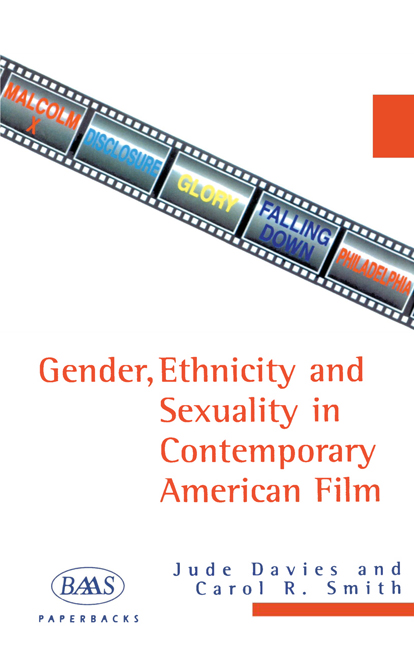Book contents
- Frontmatter
- Contents
- Acknowledgements
- Introduction: The Uses of Identity in Post-Reagan Hollywood Film
- 1 White Masculinity as Paternity: Michael Douglas, Fatherhood and the Uses of the American Family
- 2 Transactions in Race and Ethnicity: Positive, Negative and Interrogative Images of African Americans on Film
- 3 Putting the Homo into America: Reconstructing Gay Identities in the National Frame
- Conclusion: Aliens from Star Wars to Independence Day
- Index
- Miscellaneous Endmatter
3 - Putting the Homo into America: Reconstructing Gay Identities in the National Frame
Published online by Cambridge University Press: 24 September 2020
- Frontmatter
- Contents
- Acknowledgements
- Introduction: The Uses of Identity in Post-Reagan Hollywood Film
- 1 White Masculinity as Paternity: Michael Douglas, Fatherhood and the Uses of the American Family
- 2 Transactions in Race and Ethnicity: Positive, Negative and Interrogative Images of African Americans on Film
- 3 Putting the Homo into America: Reconstructing Gay Identities in the National Frame
- Conclusion: Aliens from Star Wars to Independence Day
- Index
- Miscellaneous Endmatter
Summary
In his affectionate interpretive history of blacks in film, Toms, Coons, Mulattoes, Mammies and Bucks, Donald Bogle says that ‘the essence of black film history is not found in the stereotyped role but in what certain talented actors have done with the stereotype’. In the same sense, the characters created by Pangbom, Sutton, Horton, Webb and dozens of others brought a brief electric contact with the quicksilver truth and wrought a comic chaos that the social order suppressed. Each in his own style, they were signposts to a hidden gay experience where chaos was the norm.
Vito Russo, The Celluloid ClosetJust as recent work on images of blacks and women has done, thinking about images of gayness needs to go beyond simply dismissing stereotypes as wrong and distorted. Righteous dismissal does not make the stereotypes go away, and tends to prevent us from understanding just what stereotypes are, how they function, ideologically and aesthetically, and why they are so resilient in the face of our rejection of them.
Richard Dyer, ‘Stereotyping’It puts the homo back in Homicide.
‘Teaser’ for Swoon (Tom Kalin, 1992)As in the previous chapters, we are concerned here not with films as revelative of specific identities, but as articulating forms of identity in symbolic terms. Our approach to discussing sexuality in film therefore is not determined by notions of ‘gay film’ and ‘lesbian film’ but instead is generated by a multifaceted concern with filmic representations of gay and lesbian identity. The groundbreaking work of Vito Russo has uncovered a history of gay representations in mainstream cinema, in ways similar to the work done on African American representations by scholars such as Bogle, Cripps, Leab and others in the 1970s. As Russo's explicit alignment with Bogle, quoted above, implies, the criteria for reading these representations derived from similar sources, notably the impetus to distinguish between positive and negative images which came from the culturalist turn of the black civil rights movement and the post-Stonewall liberation movements respectively. And also like the work on African American representations, registered presciently as above by Richard Dyer, these parameters have been problematised by critical work in the 1980s and 1990s.
- Type
- Chapter
- Information
- Gender, Ethnicity and Sexuality in Contemporary American Film , pp. 103 - 146Publisher: Edinburgh University PressPrint publication year: 2020



